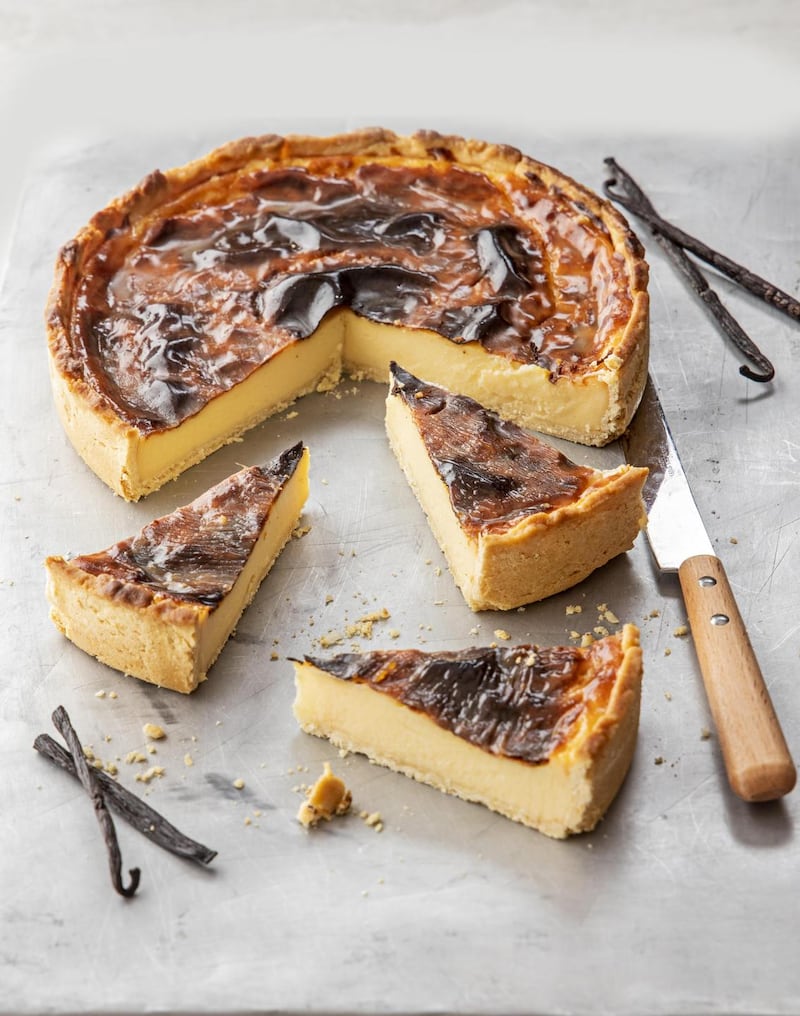As a child, the sight of a custard tart in a bakery window was a little underwhelming to me. Visually, it did not stand up to the towering cakes and billowing cream-filled goodies. It sat, demurely, not shouting its virtues, waiting to be discovered. As an adult, I was surprised to find I love them and get regular cravings for them.
Some desserts look amazing, but turn out to be composed almost entirely of air and sugar. A custard tart, on the other hand, seems to overdeliver. The whole is greater than the sum of its parts. Pastry plus custard shouldn’t taste this good.
Its simplicity means there is nowhere to hide when baking a custard tart. The pastry must be crisp to provide textural contrast to the creamy filling. The custard must be silky smooth and set, but not rubbery. It is not difficult to make a good custard tart, but it does require care and patience.
It is the recipe every French chef knows by heart. In France, it is simply called flan. A dichotomy exists between custard tart and flan. The former needs to be baked slowly at a low temperature, so you end up with custard tart and not scrambled egg. French flan has a distinctive blackened top, which I achieve by ensuring the custard-filled tart is baked from very cold, when it goes in the hot oven. Either way, it tastes best when left to cool completely before tucking in.
This recipe is very versatile, and flavours such as nutmeg or orange zest can be added. While my version has a shortcrust pastry case, the famous Portuguese mini custard tarts are puff pastry. It is vital to have no holes in the pastry or the very liquid filling will leak out.
FRENCH CUSTARD FLAN
Serves six

Ingredients
For sweet pastry:
200g plain flour, plus extra for dusting
100g cold butter, diced small
50g icing sugar
1 egg yolk
1 tsp cold water, if needed
For custard filling:
3 egg yolks
2 eggs
120g caster sugar
50g cornflour
1 tsp vanilla extract
400ml milk
250ml cream
Method
1 Preheat your oven to 180 degrees Celsius, fan, or equivalent. Grease a deep 20cm loose bottomed cake tin (I use a sandwich cake tin but you can use a tart tin not less than 2.5cm deep).
2 To make the pastry, sieve the flour into a bowl. Add the diced butter and rub into the flour with your fingertips until the mixture resembles fine breadcrumbs. Stir in icing sugar. Work in the egg yolk then add enough water to bring the mixture together to a firm dough. Shape into a flat disc. Wrap in clingfilm and chill the pastry for 20 minutes.
3 Roll the pastry out thinly to a 2mm thickness on a lightly floured work surface and use to line the greased baking tin. Lightly prick the pastry base with a fork.
4 To bake the pastry blind, cover the pastry with parchment paper and fill with baking beans (or uncooked rice). Place in the preheated oven for 20-25 minutes or until the pastry is light golden in colour. Set aside to cool completely.
5 To make the custard filling. In a large mixing bowl, whisk together the eggs, sugar, cornflour and vanilla extract until thickened and pale.
6 In a medium, heavy-based saucepan, heat the milk and cream, removing the mixture from the heat as soon as it reaches boiling point.
7 Add a small amount of the hot liquid (while whisking) into the egg mixture to temper it. Then whisk the remaining hot milk and cream into the egg mixture in a steady stream.
8 Sieve away any excess foam as you pour the mixture back into the washed and cleaned saucepan. Over a medium to high heat continue to cook the mixture, stirring continuously with a wooden spoon for at least five minutes, until the custard has thickened. Once cooked, transfer the custard to a clean bowl, cover the surface with clingfilm to stop a skin forming, and allow to cool before placing the bowl in the refrigerator for at least one hour so the custard is cold.
9 Once it is fully chilled pour the custard into the pastry shell.
10 Preheat your oven to 190 degrees Celsius, fan, or equivalent and bake the filled tart on the top shelf of the oven for approximately 40 minutes or until a deep golden crust has formed on top. Serve cold.
Variation:
To make a crustless version, omit the pastry and simply pour the custard into a lined cake tin.










